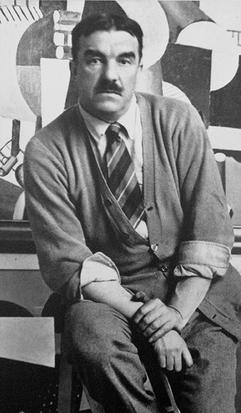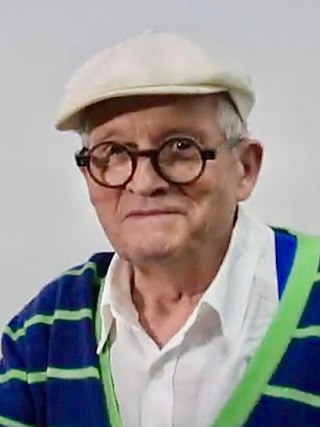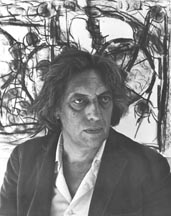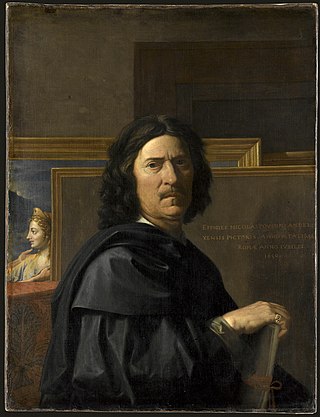
Joseph Fernand Henri Léger was a French painter, sculptor, and filmmaker. In his early works he created a personal form of cubism which he gradually modified into a more figurative, populist style. His boldly simplified treatment of modern subject matter has caused him to be regarded as a forerunner of pop art.

David Hockney is an English painter, draughtsman, printmaker, stage designer, and photographer. As an important contributor to the pop art movement of the 1960s, he is considered one of the most influential British artists of the 20th century.

Jean Dominique Antony Metzinger was a major 20th-century French painter, theorist, writer, critic and poet, who along with Albert Gleizes wrote the first theoretical work on Cubism. His earliest works, from 1900 to 1904, were influenced by the neo-Impressionism of Georges Seurat and Henri-Edmond Cross. Between 1904 and 1907, Metzinger worked in the Divisionist and Fauvist styles with a strong Cézannian component, leading to some of the first proto-Cubist works.

Jean-Édouard Vuillard was a French painter, decorative artist, and printmaker. From 1891 through 1900, Vuillard was a prominent member of the avant garde artistic group Les Nabis, creating paintings that assembled areas of pure color. His interior scenes, influenced by Japanese prints, explored the spatial effects of flattened planes of color, pattern, and form. As a decorative artist, Vuillard painted theater sets, panels for interior decoration, and designed plates and stained glass. After 1900, when the Nabis broke up, Vuillard adopted a more realistic style, approaching landscapes and interiors with greater detail and vivid colors. In the 1920s and 1930s, he painted portraits of prominent figures in French industry and the arts in their familiar settings.

Jean-Paul Riopelle, was a Canadian painter and sculptor from Quebec. He had one of the longest and most important international careers of the sixteen signatories of the Refus Global, the 1948 manifesto that announced the Quebecois artistic community's refusal of clericalism and provincialism. He is best known for his abstract painting style, in particular his "mosaic" works of the 1950s when he famously abandoned the paintbrush, using only a palette knife to apply paint to canvas, giving his works a distinctive sculptural quality. He became the first Canadian painter since James Wilson Morrice to attain widespread international recognition.
Graham Vivian Sutherland was a prolific English artist. Notable for his paintings of abstract landscapes and for his portraits of public figures, Sutherland also worked in other media, including printmaking, tapestry and glass design.

Orphism or Orphic Cubism, a term coined by the French poet Guillaume Apollinaire in 1912, was an offshoot of Cubism that focused on pure abstraction and bright colors, influenced by Fauvism, the theoretical writings of Paul Signac, Charles Henry and the dye chemist Michel Eugène Chevreul. This movement, perceived as key in the transition from Cubism to Abstract art, was pioneered by František Kupka, Robert Delaunay and Sonia Delaunay, who relaunched the use of color during the monochromatic phase of Cubism. The meaning of the term Orphism was elusive when it first appeared and remains to some extent vague.

Paul Nash was a British surrealist painter and war artist, as well as a photographer, writer and designer of applied art. Nash was among the most important landscape artists of the first half of the twentieth century. He played a key role in the development of Modernism in English art.

Auguste Herbin was a French painter of modern art. He is best known for his Cubist and abstract paintings consisting of colorful geometric figures. He co-founded the groups Abstraction-Création and Salon des Réalités Nouvelles which promoted non-figurative abstract art.
William Tillyer is a British artist working within painting, watercolour and the printmaking tradition. His approach is constantly evolving; redefining and reinterpreting classic subject matter, such as landscapes, still lifes and portraits, in methods that challenge historical traditions and vary between bodies of work. Since the 1950s, Tillyer has exhibited internationally, and his work can be found in the collections of major institutions including the Arts Council of Great Britain, the Brooklyn Art Museum, the Museum of Modern Art (MOMA), Tate Britain and the Victoria and Albert Museum. There are at least 15 works by Tillyer in the Tate collection, including High Force (1974).

Warter is a small village and civil parish in the East Riding of Yorkshire, England. It is situated approximately 4 miles (6.4 km) east of Pocklington on the B1246 road and 18 miles (29 km) from the city of York.

The Four Seasons was the last set of four oil paintings completed by the French painter Nicolas Poussin (1594–1665). The set was painted in Rome between 1660 and 1664 for the Duc de Richelieu, the grand-nephew of Cardinal Richelieu. Each painting is an elegiac landscape with Old Testament figures conveying the different seasons and times of the day. Executed when the artist was in failing health suffering from a tremor in his hands, the Seasons are a philosophical reflection on the order in the natural world. The iconography evokes not only the Christian themes of death and resurrection but also the pagan imagery of classical antiquity: the poetic worlds of Milton's Paradise Lost and Virgil's Georgics. The paintings currently hang in a room on their own in the Louvre in Paris.
By his absolute humility, by his effacement of himself, by his refusal to use any tricks or overstate himself, Poussin has succeeded in identifying himself with nature, conceived as a manifestation of the divine reason. The Seasons are among the supreme examples of pantheistic landscape painting.
Jamais peut-être, dans toute la peinture occidentale, des choses aussi nombreuses et parfois si difficiles n'avaient été dites avec une telle simplicité. Jamais un peintre ne s'était aussi pleinement identifié à l'ordre du monde. Mais cette identification n'est ni « une projection » ni une confidence : là est le sens de cette impersonalité que l'on a pu reprocher à Poussin, et qui fait sa grandeur.

Mary Adshead was an English painter, muralist, illustrator and designer.

Snow at Argenteuil is an oil-on-canvas landscape painting by the Impressionist artist Claude Monet. It is the largest of no fewer than eighteen works Monet painted of his home commune of Argenteuil while it was under a blanket of snow during the winter of 1874–1875. This painting—number 352 in Wildenstein's catalogue of the works of Monet—is the largest of the eighteen. The attention to detail evident in the smaller paintings is less evident in this larger picture. Instead, Monet has rendered large areas of the canvas in closely like tones and colours of blue and grey. The application of smaller strokes of greens, yellows, reds and darker blues breaks up these large expanses, and the almost choreographed dispersal of these various colours helps bind the picture together. Paint at the depicted road surface is thicker than elsewhere in the painting, and impasto is suggestive of the feel of disturbed snow.

A Bigger Splash is a large pop art painting by British artist David Hockney. Measuring 242.5 centimetres (95.5 in) by 243.9 centimetres (96.0 in), it depicts a swimming pool beside a modern house, disturbed by a large splash of water created by an unseen figure who has apparently just jumped in from a diving board. It was painted in California between April and June 1967, when Hockney was teaching at the University of California, Berkeley. Jack Hazan's fictionalised 1973 biopic, A Bigger Splash, concentrating on the breakup of Hockney's relationship with Peter Schlesinger, was named after the painting.

Fauvism is a style of painting and an art movement that emerged in France at the beginning of the 20th century. It was the style of les Fauves, a group of modern artists whose works emphasized painterly qualities and strong colour over the representational or realistic values retained by Impressionism. While Fauvism as a style began around 1904 and continued beyond 1910, the movement as such lasted only a few years, 1905–1908, and had three exhibitions. The leaders of the movement were André Derain and Henri Matisse.

Gaetano Giuseppe Faostino Meo was an Italian-British artist's model, landscape painter, and a noted craftsman in mosaic and stained glass. His unpublished autobiography is a useful source for art historians of the Aesthetic Movement and Edwardian Era.

We Are Making a New World is a 1918 oil-on-canvas painting by Paul Nash. The optimistic title contrasts with Nash's depiction of a scarred landscape created by a battle of the First World War, with shell-holes, mounds of earth, and leafless tree trunks. Nash's first major painting and his most famous work, it has been described as one of the best British paintings of the 20th century, and compared to Picasso's Guernica. "Yet it is worth remembering that the picture was a piece of official art and that it first appeared, untitled, as the cover of an issue of British War Artists at the Front, published by Country Life. ... [It] was promulgated in 1917 as covert propaganda for the Allied cause."

Fraisthorpe Wind Farm is a wind power generating site located in the village of Fraisthorpe in the East Riding of Yorkshire, England. The site is just 2 miles (3.2 km) south of Bridlington and 40 miles (64 km) east of York. It was granted full planning permission in early 2015 when the Ministry of Defence dropped their objection to the site. This was despite the apparent vocal opposition by local people and councillors. It started generating electricity in August 2016.

Portrait of an Artist (Pool with Two Figures) is a large acrylic-on-canvas pop art painting by British artist David Hockney, completed in May 1972. It measures 7 ft × 10 ft (2.1 m × 3.0 m), and depicts two figures: one swimming underwater and one clothed male figure looking down at the swimmer. In November 2018, it sold for US$90.3 million, at that time the highest price ever paid at auction for a painting by a living artist.


















